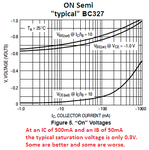boylesg
Advanced Member level 4

- Joined
- Jul 15, 2012
- Messages
- 1,023
- Helped
- 5
- Reputation
- 10
- Reaction score
- 6
- Trophy points
- 1,318
- Location
- Epping, Victoria, Australia
- Activity points
- 11,697
Suppose you bias a transistor with a single base resistor such that it will go into saturation with the maximum base current, as set by the base resistor and input voltage.
For example a 5V supply, a BC327 and a 1k base resistor - allowing a maximum base current of about 5mA
What happens if you then put say only 0.1mA through the base? Is it still regarded as saturated with a minimal CE voltage drop?
This could be the situation in a RGB LED grid where each individual led has a transistor controlling it (first tier) and then all of those transistors are further multiplexed with a second tier of transistors.
The second tier of transistor might have to 'turn on' one or more of the first tier transistors.
For example a 5V supply, a BC327 and a 1k base resistor - allowing a maximum base current of about 5mA
What happens if you then put say only 0.1mA through the base? Is it still regarded as saturated with a minimal CE voltage drop?
This could be the situation in a RGB LED grid where each individual led has a transistor controlling it (first tier) and then all of those transistors are further multiplexed with a second tier of transistors.
The second tier of transistor might have to 'turn on' one or more of the first tier transistors.

